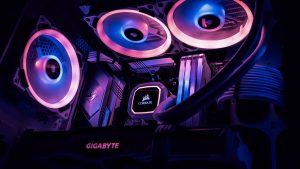Neuromorphic Processors: Brain-Like Electronics
Welcome to the future of computing – Neuromorphic processors. These brain-like electronics are revolutionizing the way we think about machine learning and AI, taking inspiration from the human brain. In this article, we explore the exciting world of Neuromorphic processors, their capabilities, and their potential impact on the future of technology.
What are Neuromorphic Processors?
Neuromorphic processors, also known as neuromorphic chips or brain-inspired chips, are electronic circuits that mimic the structure and function of the brain. They are designed to process information in a similar way to the human brain, using algorithms inspired by the brain’s neurons, synapses, and neural networks.
The first Neuromorphic processor was built by California Institute of Technology (Caltech) professor Carver Mead in the late 1980s. However, it wasn’t until the early 2000s that the technology started gaining attention, with major companies like IBM and Intel investing in research and development.
How do they work?
The brain is made up of billions of neurons that communicate with each other through electrical signals. These signals travel across synapses, which act as connections between neurons. The strength of these connections is what enables the brain to learn and adapt.
Neuromorphic processors emulate this structure and function by using analog circuits and spiking neural networks. The analog circuits allow for the processing of continuous signals, while the spiking neural networks mimic the way neurons fire in the brain. Together, these elements enable the processor to learn and make decisions in a way that is similar to the human brain.
Advantages of Neuromorphic Processors
Improved Energy Efficiency
One of the major advantages of Neuromorphic processors is their energy efficiency. Traditional processors, also known as Von Neumann machines, require large amounts of energy to process information, resulting in high power consumption and heat generation. In contrast, Neuromorphic processors operate using low power and produce less heat, making them more energy-efficient.
Rapid Learning and Adaptability
Neuromorphic processors have the ability to learn and adapt in real-time, just like the brain. This means that they can continuously improve their performance and adapt to different situations, unlike traditional processors, which require reprogramming for each new task.
High-Speed Processing
Due to their parallel processing capabilities, Neuromorphic processors can handle massive amounts of data at high speeds. This makes them ideal for tasks that require large-scale data processing, such as image and speech recognition, natural language processing, and autonomous driving.
The Future of Neuromorphic Processors
The potential applications for Neuromorphic processors are vast and diverse. They have already been used in various fields, including robotics, artificial intelligence, and neuroscience. However, their full potential is yet to be realized.
In the future, we could see Neuromorphic processors being used to power intelligent devices and machines with human-like abilities. They could also revolutionize fields like medicine, by helping to diagnose diseases, and engineering, by enabling the development of more efficient structures and systems.
Challenges and Limitations
While there is much excitement surrounding Neuromorphic processors, there are still some challenges and limitations to overcome. The technology is still in its early stages, and there is a lack of standardized programming language and tools for building neuromorphic systems. Additionally, there are concerns about the reliability and reproducibility of results produced by these processors.
Another notable challenge is the complexity of the human brain itself. While Neuromorphic processors are inspired by the brain, they do not possess the same level of intelligence and complexity. As a result, they may not be able to fully replicate all of the brain’s functions.
The Bottom line
Neuromorphic processors represent a significant breakthrough in the world of computing. With their energy efficiency, rapid learning and adaptability, and high-speed processing capabilities, they have the potential to revolutionize various industries and drive technological advancements in ways that were previously thought to be impossible. As the technology continues to evolve, we can expect to see more impressive innovations and real-world applications of Neuromorphic processors.
Are you excited about the future of Neuromorphic processors? Let us know in the comments below!










